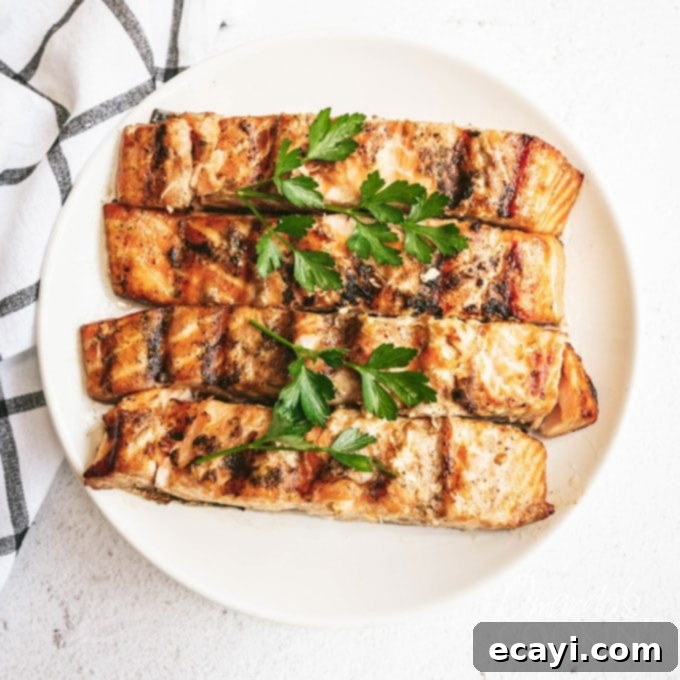Mastering Grilled Salmon: A Flavorful Recipe for Perfect Fillets
Salmon is widely celebrated as a powerhouse of nutrition, teeming with high-quality protein, essential omega-3 fatty acids, and a rich array of vitamins and minerals. Among the many ways to prepare this magnificent fish, grilling stands out as a supremely delicious and straightforward method, transforming simple fillets into a tender, flaky, and deeply flavorful meal. Our grilled salmon recipe, featuring a tantalizing marinade, promises to elevate your weeknight dinner or summer barbecue into a truly memorable culinary experience. It’s not just a meal; it’s a step towards a healthier, more vibrant you.
Pairing this exquisite main dish with complementary sides enhances the entire dining experience. Consider serving your grilled salmon with grilled asparagus, a vibrant and equally nutritious option that cooks beautifully alongside the fish, or perhaps some fresh garden greens for a light and refreshing balance.
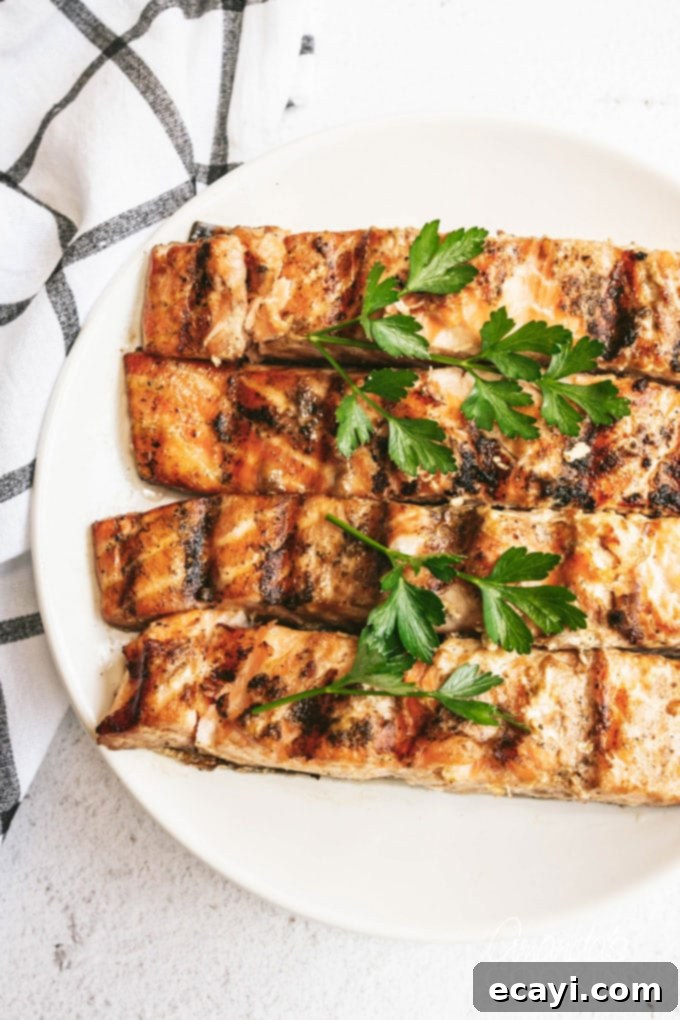
Why You’ll Love This Easy Grilled Salmon Recipe
Preparing seafood on the grill might seem intimidating, but this recipe is designed to be accessible and rewarding for cooks of all skill levels. Here’s why this grilled salmon will quickly become a favorite in your culinary repertoire:
- Unbeatable Flavor: Our signature marinade infuses the salmon with a savory, sweet, and subtly tangy profile that caramelizes beautifully on the grill, creating an irresistible crust and juicy interior.
- Nutrient-Rich: You’re not just enjoying a tasty meal; you’re nourishing your body with vital omega-3s, lean protein, and essential vitamins and minerals crucial for heart health, brain function, and overall well-being.
- Quick & Convenient: While the marinating time requires a bit of foresight, the actual grilling takes less than 15 minutes! This makes it an ideal choice for busy weeknights when you want something impressive yet fast.
- Effortless Preparation: With clear, step-by-step instructions, you’ll master the art of grilling salmon without any fuss. The key is in the preparation and a few simple techniques.
- Versatile Pairing: Grilled salmon is incredibly versatile. It pairs wonderfully with a myriad of side dishes, from simple salads and steamed vegetables to roasted potatoes or rice, allowing for endless meal combinations.
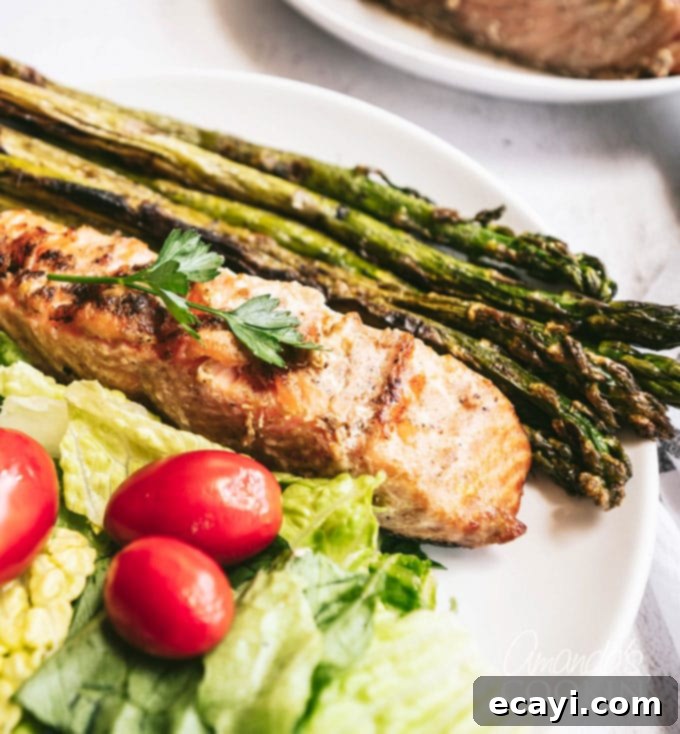
The Health Benefits of Incorporating Salmon into Your Diet
Beyond its delectable taste, salmon is a nutritional powerhouse that offers a myriad of health advantages. Understanding these benefits can further inspire you to make this remarkable fish a regular part of your meals:
- Rich in Omega-3 Fatty Acids: Salmon is one of the best sources of long-chain omega-3s, EPA and DHA, which are crucial for brain function, eye health, and reducing inflammation. These fatty acids are known to lower the risk of heart disease, improve cholesterol levels, and support joint health.
- Excellent Source of Protein: Providing a significant amount of high-quality protein, salmon aids in muscle repair, growth, and maintaining bone health. Protein also helps you feel full and satisfied, which can assist in weight management.
- Packed with B Vitamins: Salmon contains a full spectrum of B vitamins, including B12, B6, niacin, and thiamine. These vitamins are essential for energy production, DNA repair, and maintaining a healthy nervous system.
- Good Source of Potassium: This mineral is vital for blood pressure control and can help reduce the risk of stroke. Salmon provides more potassium than an equivalent amount of bananas!
- Loaded with Selenium: Selenium is a trace mineral that acts as a powerful antioxidant, protecting the body from oxidative damage and supporting thyroid function.
- Contains Vitamin D: One of the few food sources of Vitamin D, salmon contributes to bone health, immune function, and overall well-being. Many people are deficient in this crucial vitamin, making salmon an excellent dietary inclusion.
By making conscious choices to include more nutrient-dense foods like grilled salmon, you’re investing in your long-term health and vitality. This delicious dish offers a simple and enjoyable way to boost your intake of these essential nutrients.
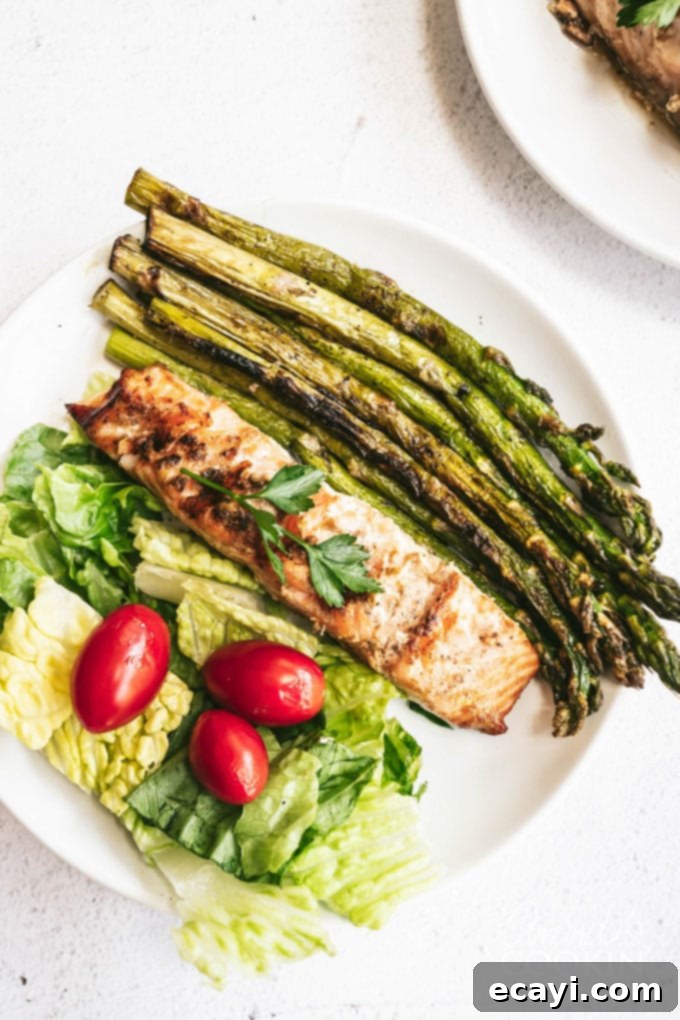
Grilled Salmon Recipe: Step-by-Step Guide to Perfection
Grilling salmon is a fantastic method that imparts a smoky flavor and a beautiful sear while keeping the fish incredibly moist and tender. The secret to success lies in a few key steps and a little patience. While it might seem daunting to cook fish on the grill, with the right approach, you’ll be serving up perfectly grilled salmon every time. The main challenges often involve preventing sticking and knowing when the fish is cooked through without drying it out. Don’t worry, we’ll cover all the essential tips.
RELATED: Enhance your meal with a creamy, herby sauce like this Rosemary Cream Sauce.
How to Tell When Salmon is Cooked
A common question when grilling fish is, “How can you tell when salmon is fully cooked?” The cooking time for salmon truly depends on the thickness of your fillets. Generally, salmon is done when it’s just barely opaque throughout the thickest part and flakes easily with a fork. It should still look moist, not dry. An internal temperature of 145°F (63°C) is ideal for perfectly cooked salmon. Using a meat thermometer is the most accurate way to ensure it’s safely cooked without overdoing it.
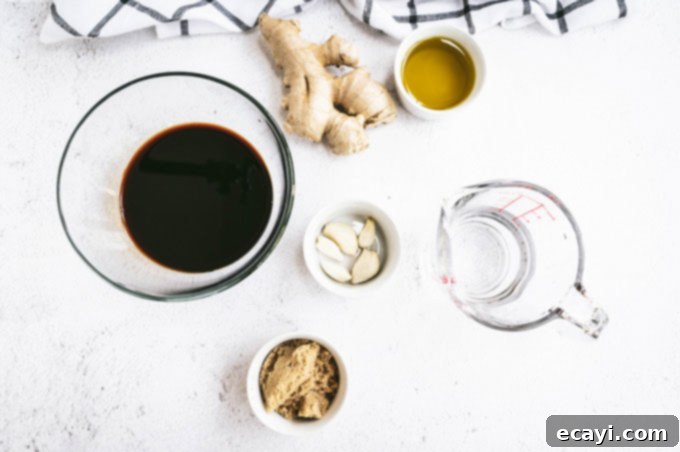
Ingredients You’ll Need for Grilled Salmon:
This recipe calls for fresh salmon fillets and a simple yet impactful marinade that brings out the best in the fish.
- 2 pounds salmon fillets, skin-on: Opt for skin-on fillets as the skin acts as a protective layer, preventing the delicate flesh from sticking to the grill and helping to keep it moist.
- Salt and pepper to taste: Basic seasonings to enhance the salmon’s natural flavor.
- Canola oil (for grill grates): Essential for preventing sticking, especially with delicate fish like salmon.
For the Delicious Marinade:
Our marinade is the secret to tender, flavorful grilled salmon. Each ingredient plays a crucial role:
- Soy Sauce: Provides a rich umami base and a salty kick. We recommend using a low sodium variety to control the overall saltiness. For those following a low-carb diet, Coconut Aminos makes an excellent, flavorful substitute.
- Water: Helps to dilute the soy sauce and ensure the marinade covers the fillets evenly without being overly concentrated.
- Fresh Grated Ginger Root: The bright, zesty, and slightly spicy notes of fresh ginger are indispensable. Do not substitute with dried ground ginger, as the flavor profile is vastly different. A box grater or microplane makes grating ginger root simple.
- Garlic: We call for five glorious cloves of minced garlic because garlic adds a deep, aromatic flavor that complements the salmon perfectly. Freshly minced garlic is always best.
- Packed Brown Sugar: This adds a lovely sweetness to balance the savory and pungent notes of the other ingredients, and aids in creating that desirable caramelization on the grill. If you’re managing carbohydrate intake, Swerve brown sugar is a fantastic low-carb alternative.
- Olive Oil: Essential for emulsifying the marinade and helping it adhere to the salmon, contributing to moisture and a rich mouthfeel. Extra virgin olive oil is preferred for its quality and flavor.
Helpful Kitchen Tools:
Having the right tools makes grilling salmon even easier and more enjoyable.
- Plastic zipper gallon bag or glass baking dish: Perfect for marinating the salmon evenly and efficiently.
- Whisk: For thoroughly combining your marinade ingredients.
- Grill: Any outdoor grill (gas or charcoal) will work wonders for this recipe.
- Tongs and a metal spatula: Absolutely essential for carefully handling delicate fish fillets on the grill without breaking them. Using both provides the best support.
How to Make Grilled Salmon: Step-by-Step Instructions
Follow these detailed steps to achieve perfectly grilled, succulent salmon every time. Remember, preparation is key!
- Prepare the Salmon: Begin by cutting your salmon fillets into approximately 2-inch wide portions. This size helps ensure even cooking and easier handling on the grill. Season each fillet generously with salt and freshly ground black pepper on both sides.
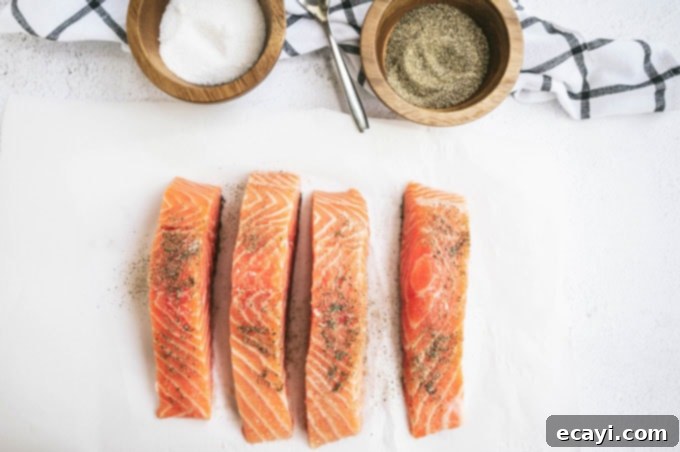
- Mix the Marinade: In a medium-sized bowl or a large measuring cup, combine all the marinade ingredients: soy sauce, water, fresh grated ginger root, minced garlic, packed brown sugar, and olive oil. Whisk everything together thoroughly until the brown sugar is completely dissolved. This ensures all flavors are well-integrated.
- Marinate the Salmon: Place the seasoned salmon fillets into a large resealable plastic bag or a shallow glass baking dish. Pour the prepared marinade over the salmon, ensuring all pieces are well-coated. Seal the bag (or cover the dish) and refrigerate for a minimum of 2 hours. Marinating for this duration allows the flavors to deeply penetrate the fish, resulting in a more succulent and flavorful outcome.
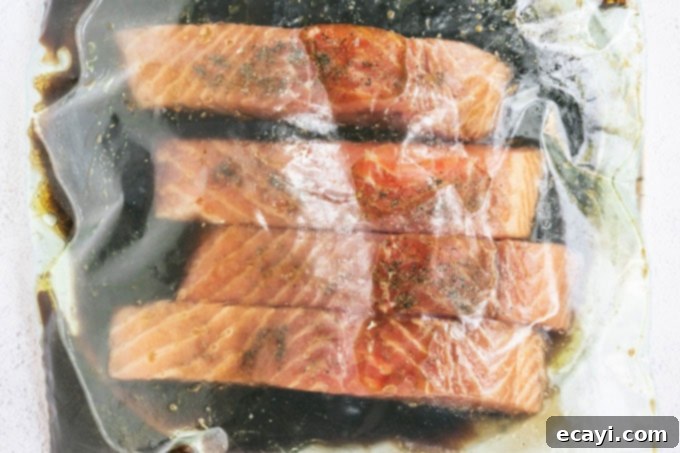
- Prepare for Grilling: Before you start grilling, remove the salmon fillets from the marinade. It’s crucial to discard the used marinade for food safety reasons; never reuse marinade that has been in contact with raw fish unless it has been brought to a rolling boil.
- Preheat Your Grill: Preheat your grill to medium heat. For most grills, this means reaching a temperature around 375-400°F (190-200°C). A properly preheated grill is essential for achieving a good sear and preventing sticking.
- Oil the Grill Grates: This step is non-negotiable for delicate fish. Grasp a wad of paper towel with your tongs, dip it into canola oil (or another high smoke point oil), and carefully run it across the hot grill grates several times. This creates a non-stick surface.
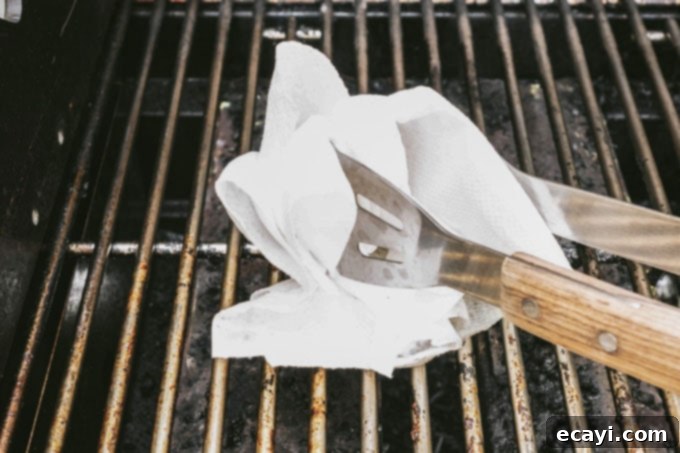
- First Side Grill: Carefully place the salmon fillets on the oiled grill grates, ensuring the skinless side (or presentation side if there’s no skin) is facing down. Close the grill lid and cook undisturbed for 3-5 minutes. The exact time will depend on the thickness of your fillets. Resisting the urge to move the fish too early is key to developing those beautiful grill marks and preventing it from sticking.
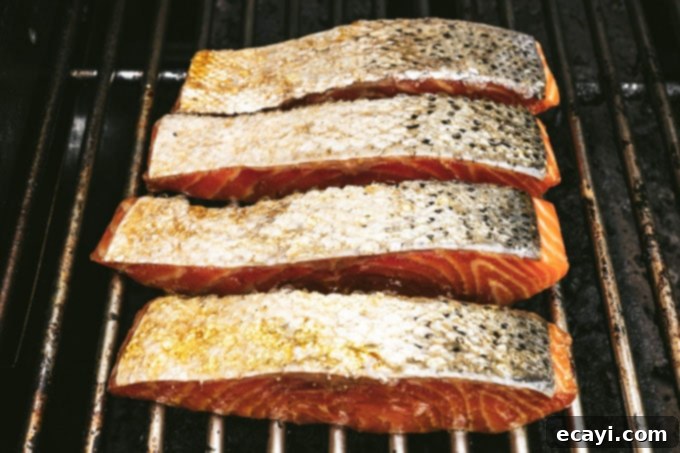
- Check for Marks: After 3-5 minutes, gently lift a corner of a fillet to check for grill marks. You should see distinct marks and a small layer of opaque, cooked flesh along the bottom. This indicates it’s ready to flip.
- Flip the Salmon: Use both your tongs and a metal spatula to carefully turn the fillets over onto the other side, so the skin side is now down (if using skin-on). The combination of tools provides optimal support and prevents the delicate fish from breaking apart.
- Adjust Heat: If using a gas grill, reduce the heat to medium-low. If you’re using a charcoal grill, move the fillets to the indirect heat side of the grill. This helps to cook the salmon through without burning the skin or overcooking the top.
- Finish Cooking: Close the lid and continue to cook for another 3-5 minutes. Again, the cooking time will vary based on fillet thickness. The salmon is done when it’s just barely opaque throughout and flakes easily with a fork. You can check the internal temperature with a meat thermometer; it should read 145°F (63°C).
- Serve Immediately: Remove the perfectly grilled salmon from the grill. It’s best served hot and fresh. A squeeze of fresh lemon juice before serving can brighten the flavors beautifully. Enjoy with your favorite side dishes like Grilled Corn on the Cob.
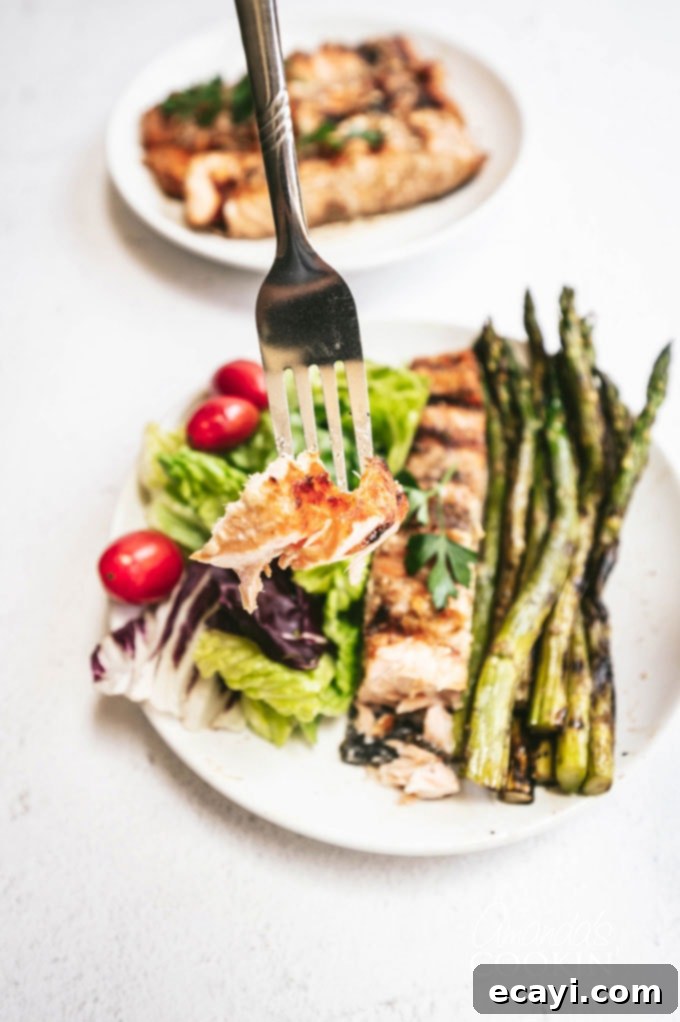
Expert Tips for Grilling Salmon Like a Pro
Achieving restaurant-quality grilled salmon at home is simpler than you might think with these expert tips:
- Clean Grill Grates are Essential: Always start with clean grill grates. Any leftover food particles can cause the salmon to stick. Use a sturdy grill brush to remove debris before preheating.
- Oil Generously: Once the grill is hot, oil the grates thoroughly. This creates a non-stick barrier. The canola oil method with a paper towel and tongs is highly effective.
- Don’t Flip Too Soon: Patience is a virtue when grilling fish. Let the salmon cook undisturbed for the initial few minutes. This allows a crust to form, making it much easier to flip without tearing.
- Use Skin-On Fillets: If possible, opt for skin-on salmon. The skin provides a natural barrier between the delicate flesh and the hot grates, preventing sticking and retaining moisture. Plus, crispy grilled salmon skin is delicious!
- Two Tools for Flipping: As mentioned in the recipe, use both tongs and a wide metal spatula when flipping. Slide the spatula completely under the fillet for support, then use the tongs to stabilize it as you turn.
- Avoid Overcrowding the Grill: Cook in batches if necessary. Overcrowding lowers the grill temperature and can lead to uneven cooking and steaming instead of grilling.
- Don’t Overcook: Salmon cooks quickly. Overcooked salmon becomes dry and tough. Aim for “barely opaque” throughout or 145°F (63°C) internal temperature. It will continue to cook slightly after removal from the grill (carryover cooking).
- Let it Rest (Briefly): While not as critical as with larger cuts of meat, a minute or two of rest off the grill allows the juices to redistribute, resulting in a more tender fillet.
Delicious Serving Suggestions for Your Grilled Salmon
Grilled salmon is incredibly versatile and pairs well with a wide variety of side dishes. Here are some ideas to complete your meal:
- Grilled Vegetables: Complement the smoky flavor of the salmon with other grilled favorites like our Grilled Asparagus, bell peppers, zucchini, or onions.
- Corn on the Cob: Sweet Grilled Corn on the Cob adds a wonderful summery touch and a burst of sweetness.
- Fresh Salads: A light, refreshing green salad with a vinaigrette dressing provides a perfect contrast to the rich salmon.
- Rice or Quinoa: A simple bed of fluffy white rice, brown rice, or quinoa can absorb the delicious flavors and make the meal more substantial.
- Roasted Potatoes: Crispy roasted potatoes or sweet potato wedges are always a crowd-pleaser.
- Lemon Wedges & Fresh Herbs: A simple squeeze of fresh lemon juice just before serving brightens all the flavors. Garnish with fresh dill or parsley for a pop of color and herbaceous notes.
- Sauces: While the marinade provides ample flavor, a dollop of a creamy dill sauce, a fresh pesto, or even a simple squeeze of lemon butter can elevate the dish further. Don’t forget the previously mentioned Rosemary Cream Sauce!
Storage and Reheating Your Leftover Salmon
If you happen to have any leftover grilled salmon, storing and reheating it properly ensures it remains delicious for another meal.
- Storage: Allow the salmon to cool completely before transferring it to an airtight container. Store it in the refrigerator for up to 2-3 days.
- Reheating: To reheat, gently warm the salmon in a preheated oven at 275°F (135°C) for about 10-15 minutes, or until just warmed through. You can also use an air fryer at a low temperature for a few minutes. Avoid high heat or microwaving, as this can dry out the fish and make it rubbery.
Frequently Asked Questions About Grilled Salmon
Here are answers to some common questions about grilling salmon, to help you feel even more confident in the kitchen:
- Can I use skin-off salmon fillets?
- Yes, you can, but skin-on is generally recommended for grilling as the skin helps prevent the delicate flesh from sticking to the grates and keeps the fish moist. If using skin-off, be extra diligent about cleaning and oiling your grill grates, and ensure your spatula is wide enough for careful handling.
- How long should I marinate the salmon?
- For this recipe, 2 hours is ideal. This allows the flavors to infuse without the acidic components of the marinade (like soy sauce, if not balanced) beginning to “cook” or denature the fish, which can happen with longer marination times, especially for delicate fish.
- What type of grill is best for salmon?
- Both gas and charcoal grills work beautifully. Gas grills offer precise temperature control, while charcoal grills impart a distinct smoky flavor. The key is maintaining a consistent medium heat and properly oiling the grates.
- My salmon keeps sticking to the grill, what am I doing wrong?
- The most common reasons for sticking are: 1) dirty grill grates, 2) insufficient oiling of the grates, 3) not allowing the grill to fully preheat, or 4) flipping the fish too soon before a crust has formed. Make sure your grates are sparkling clean, well-oiled, hot, and that you give the salmon time to sear before attempting to flip.
- Can I use frozen salmon?
- Absolutely! Just be sure to thaw the salmon completely in the refrigerator overnight before marinating and grilling. Pat it dry with paper towels to remove any excess moisture before seasoning and adding to the marinade.
- What’s the best way to get crispy skin?
- To achieve crispy skin, place the salmon skin-side down on a hot, well-oiled grill. Cook it for most of the cooking time on the skin side, pressing gently to ensure full contact with the grates. This allows the skin to render its fat and crisp up beautifully.
More Irresistible Salmon Recipes You Might Like:
If you’ve fallen in love with cooking salmon, there’s a whole world of delicious recipes to explore! Here are a few more ways to enjoy this incredible fish:
- Dijon Lemon Caper Salmon
- Salmon Tacos
- Sheet Pan Salmon Dinner
- And don’t miss out on all of our grill recipes for more outdoor cooking inspiration!
- Baked Salmon
- Maple Soy Salmon
- Cedar Plank Salmon
- Poached Salmon
- Blackened Salmon
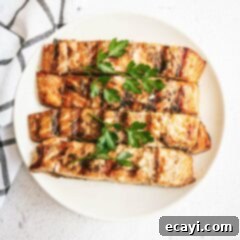
Grilled Salmon
IMPORTANT – There are often Frequently Asked Questions within the blog post that you may find helpful. Simply scroll back up to read them!
Print It
Rate It
Save ItSaved!
Ingredients
- 2 pounds salmon fillets skin-on
- Salt and pepper to taste
- canola oil for grill grates
Marinade:
- ½ cup soy sauce
- ½ cup water
- 1 tablespoon fresh grated ginger root
- 5 cloves garlic minced
- ¼ cup packed brown sugar
- ¼ cup olive oil
Before You Begin
Instructions
-
Cut salmon fillets 2-inches wide. Season fillets with salt and pepper.
-
Combine marinade ingredients in a bowl or large measuring cup. Whisk until the sugar is completely dissolved.
-
Place salmon fillets into a large resealable plastic bag. Pour in the marinade and refrigerate for 2 hours.
-
Before grilling, remove fillets from marinade and discard marinade.
-
Preheat grill to medium heat.
-
Lightly oil grill grate. Grasp a wad of paper towel with tongs and dip into canola oil then run across the hot grates.
-
Place salmon fillets on the grill, skinless side down. Close the lid and cook 3-5 minutes, undisturbed.
-
Turn fillets over. There should be grill marks on the fish and a small layer of opaque flesh on the cooked side.
-
Use tongs and a metal spatula to turn the filets onto the other side, so that the skin side is down.
-
Reduce grill heat to medium, or if using charcoal, move to indirect heat side.
-
Close the lid and cook for another 3-5 minutes. The time will depend on how thick your fillets are. Salmon should be just barely opaque throughout when done.
-
Remove from grill and serve immediately.
Nutrition
The recipes on this blog are tested with a conventional gas oven and gas stovetop. It’s important to note that some ovens, especially as they age, can cook and bake inconsistently. Using an inexpensive oven thermometer can assure you that your oven is truly heating to the proper temperature. If you use a toaster oven or countertop oven, please keep in mind that they may not distribute heat the same as a conventional full sized oven and you may need to adjust your cooking/baking times. In the case of recipes made with a pressure cooker, air fryer, slow cooker, or other appliance, a link to the appliances we use is listed within each respective recipe. For baking recipes where measurements are given by weight, please note that results may not be the same if cups are used instead, and we can’t guarantee success with that method.
